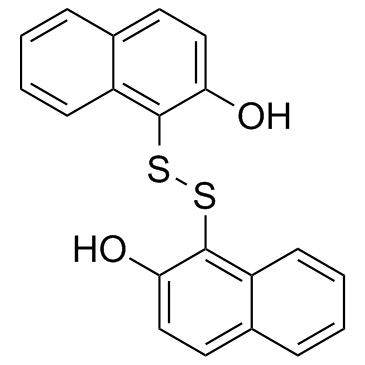IPA-3

IPA-3 structure
|
Common Name | IPA-3 | ||
|---|---|---|---|---|
| CAS Number | 42521-82-4 | Molecular Weight | 350.454 | |
| Density | 1.5±0.1 g/cm3 | Boiling Point | 543.7±35.0 °C at 760 mmHg | |
| Molecular Formula | C20H14O2S2 | Melting Point | 172℃ | |
| MSDS | Chinese USA | Flash Point | 263.4±24.7 °C | |
| Symbol |


GHS05, GHS09 |
Signal Word | Danger | |
|
Essential role of endocytosis for interleukin-4-receptor-mediated JAK/STAT signalling.
J. Cell Sci. 128 , 3781-95, (2015) Many important signalling cascades operate through specialized signalling endosomes, but a corresponding mechanism has as yet not been described for hematopoietic cytokine receptors. Based on live-cell affinity measurements, we recently proposed that ligand-i... |
|
|
PAK1 regulates RUFY3-mediated gastric cancer cell migration and invasion.
Cell Death Dis. 6 , e1682, (2015) Actin protrusion at the cell periphery is central to the formation of invadopodia during tumor cell migration and invasion. Although RUFY3 (RUN and FYVE domain containing 3)/SINGAR1 (single axon-related1)/RIPX (Rap2 interacting protein X) has an important rol... |
|
|
AP-2-associated protein kinase 1 and cyclin G-associated kinase regulate hepatitis C virus entry and are potential drug targets.
J. Virol. 89(8) , 4387-404, (2015) Hepatitis C virus (HCV) enters its target cell via clathrin-mediated endocytosis. AP-2-associated protein kinase 1 (AAK1) and cyclin G-associated kinase (GAK) are host kinases that regulate clathrin adaptor protein (AP)-mediated trafficking in the endocytic a... |
|
|
Influenza A virus uses intercellular connections to spread to neighboring cells.
J. Virol. 89(3) , 1537-49, (2015) In the extracellular environment, cell-free virions seek out naive host cells over long distances and between organisms. This is the primary mechanism of spread for most viruses. Here we provide evidence for an alternative pathway previously undescribed for o... |
|
|
Oncogenic role of Merlin/NF2 in glioblastoma.
Oncogene 34 , 2621-30, (2015) Glioblastoma is the most common and aggressive primary brain tumor in adults, with a poor prognosis because of its resistance to radiotherapy and chemotherapy. Merlin/NF2 (moesin-ezrin-radixin-like protein/neurofibromatosis type 2) is a tumor suppressor found... |
|
|
Disruption of Sphingolipid Biosynthesis Blocks Phagocytosis of Candida albicans.
PLoS Pathog. 11 , e1005188, (2015) The ability of phagocytes to clear pathogens is an essential attribute of the innate immune response. The role of signaling lipid molecules such as phosphoinositides is well established, but the role of membrane sphingolipids in phagocytosis is largely unknow... |
|
|
Productive Entry of Foot-and-Mouth Disease Virus via Macropinocytosis Independent of Phosphatidylinositol 3-Kinase.
Sci. Rep. 6 , 19294, (2016) Virus entry is an attractive target for therapeutic intervention. Here, using a combination of electron microscopy, immunofluorescence assay, siRNA interference, specific pharmacological inhibitors, and dominant negative mutation, we demonstrated that the ent... |
|
|
PKA-dependent phosphorylation of LIMK1 and Cofilin is essential for mouse sperm acrosomal exocytosis.
Dev. Biol. 405 , 237-49, (2015) Mammalian sperm must acquire their fertilizing ability after a series of biochemical modifications in the female reproductive tract collectively called capacitation to undergo acrosomal exocytosis, a process that is essential for fertilization. Actin dynamics... |
|
|
p21-Activated kinase 1 (Pak1) phosphorylates BAD directly at serine 111 in vitro and indirectly through Raf-1 at serine 112.
PLoS ONE 6 , e27637, (2011) Cell survival depends on the balance between protective and apoptotic signals. When the balance of signals tips towards apoptosis, cells undergo programmed cell death. This balance has profound implications in diseases including cancer. Oncogenes and tumor su... |
|
|
Different Rho GTPase-dependent signaling pathways initiate sequential steps in the consolidation of long-term potentiation.
J. Cell Biol. 186 , 85-97, (2009) The releasable factor adenosine blocks the formation of long-term potentiation (LTP). These experiments used this observation to uncover the synaptic processes that stabilize the potentiation effect. Brief adenosine infusion blocked stimulation-induced actin ... |